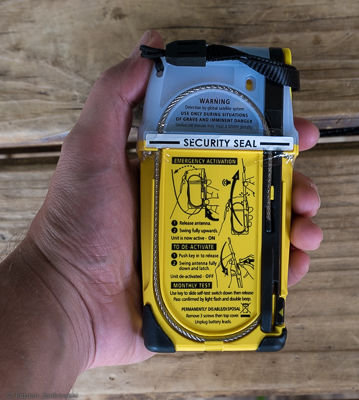Personal locator beacons (PLBs) are satellite devices that transmit a distress signal to search and rescue organisations once they are activated. Because they transmit the signal via satellites, they can be used in remote locations, where no cell phone access is available. Here I explain how they operate and why they are important to have in remote wilderness areas.

In the following, I am going to argue that PLBs are a useful addition to the equipment list for anyone who is away from emergency services and is out of cell phone coverage. In particular, they are incredibly helpful for anyone who is exercising some potentially dangerous activities in a remote outdoor setting. This includes activities such as hiking in remote wilderness areas, mountaineering, rock climbing, kayaking and so forth. Especially if they are carried out solo or in a small group only, it is highly recommended to carry a PLB.
Overview
PLBs are related to EPIRBs (Emergency Position-Indicating Radio Beacons), which are mainly used in boats and ships and usually are permanently installed in a vessel. However, they are much smaller and lighter hand-held devices intended to be carried by a person.
They are designed as a form of backup communication in case all other options fail when a person is in a life-threatening situation. If cell phone reception is available, or any other type of two-way communication such as CB radios, that is the preferable option.
Technical Operation
On the technical side, nearly all currently available PLBs include a Global Positioning System (GPS) receiver. Once activated, the PLB determines its current location using GPS and starts transmitting it to a satellite constellation at a frequency of 406 MHz. It also sends additional information, such as its device and registration number. The registration number is directly linked to its registrant and makes it possible for the search and rescue operators to identify the potential person in distress. The integration of a GPS receiver has the advantage that a more accurate position is available to the rescue services. That means that they need to search a much smaller area and will hopefully find the person faster. In addition to the 406 MHz signal, most devices also transmit a homing signal at 121.5 MHz.
Most PLB models utilise the COSPAS-SARSAT satellite system, but there are others that use the Iridium satellites and offer two-way communication via text messages. Some of them require a monthly subscription to keep the device active. The majority, however, are free after the initial purchase.
Recommendation
The good news is that PLBs can be hired for a small fee from some national park service centres in Australia. However, if you use it often, it makes more sense to buy one.
If you venture into remote wilderness areas, I would strongly recommend investing in a PLB. More so if you do that solo, or in a small group only. It will likely be the only way that you can alert emergency services in case of a severe injury, snake bite, etc. Even for trips into less remote wilderness areas the convenience that you can stay with an injured person, instead of having to search for a place with cell phone reception makes it worth having it.